Nursing Case Study: Levitt-Jones' Clinical Reasoning Cycle and CKD
VerifiedAdded on 2022/10/12
|8
|2255
|14
Case Study
AI Summary
This case study focuses on George, an elderly Aboriginal patient diagnosed with Chronic Kidney Disease (CKD). The paper analyzes George's condition, highlighting the importance of identifying and prioritizing patient needs, especially for vulnerable populations. It applies Levitt-Jones' Clinical Reasoning Cycle to determine key management priorities, including addressing depression and anxiety, implementing lifestyle changes for diabetes management, considering genetic factors, and improving communication. The case study also discusses the patient's medication regimen and lab results, including elevated blood pressure, albuminuria, and imbalanced blood sugar levels. It emphasizes the need for regular monitoring of kidney function, appropriate medication administration, and dietary considerations to improve patient outcomes. The paper concludes by underscoring the significance of comprehensive patient assessment and care for individuals with CKD.
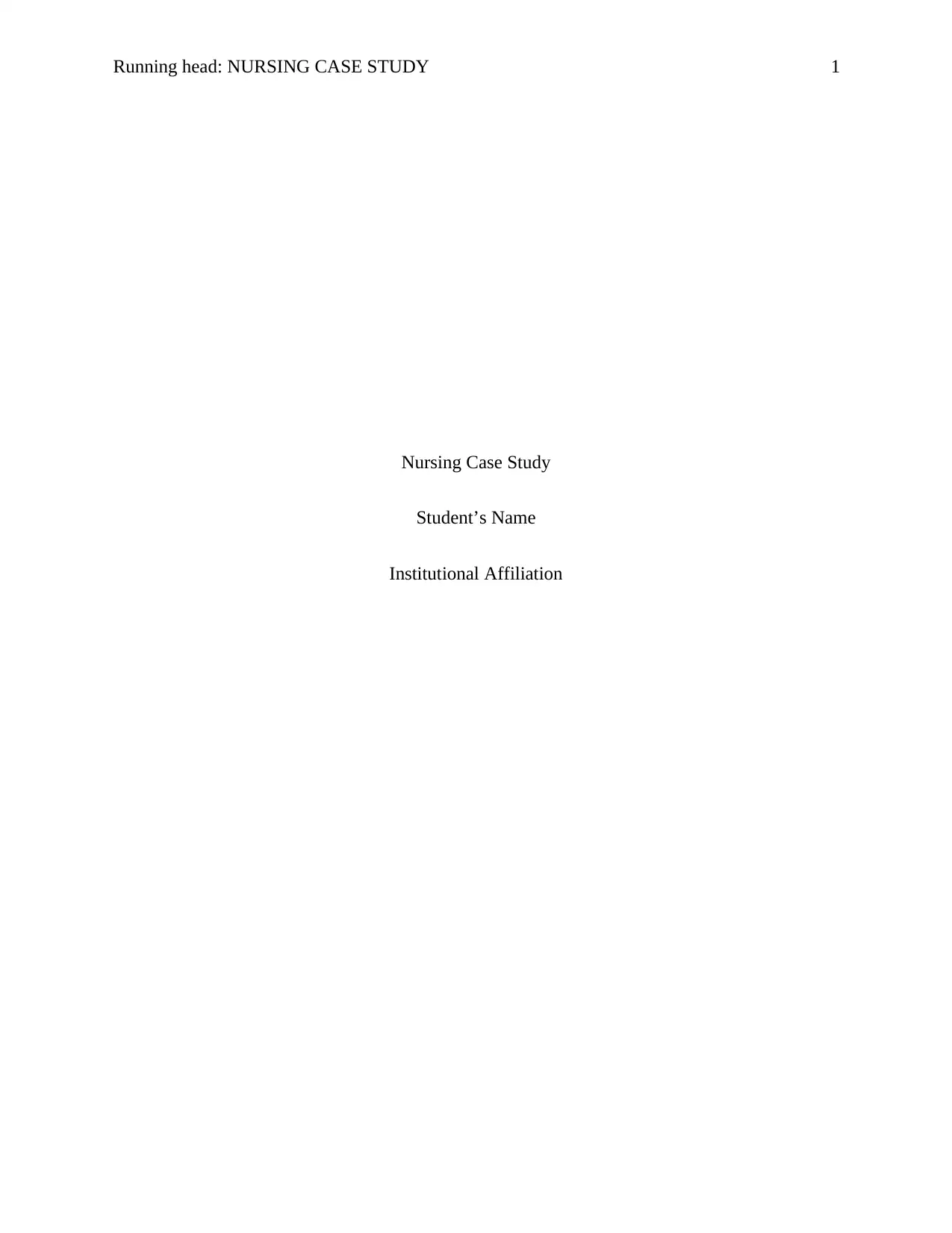
Running head: NURSING CASE STUDY 1
Nursing Case Study
Student’s Name
Institutional Affiliation
Nursing Case Study
Student’s Name
Institutional Affiliation
Paraphrase This Document
Need a fresh take? Get an instant paraphrase of this document with our AI Paraphraser

NURSING CASE STUDY 2
Introduction
Medical mistakes and errors can lead to poor quality of healthcare services. Therefore, all
healthcare providers should always understand the needs and expatiations of patients during the
provision of healthcare services. Identification of patient’s priorities is vital during decision-
making and designing of different models that can enhance the provision of desired healthcare
services. After the patient’s priorities is determined, it also essential for the priorities to be
ranked according to the most applicable and appropriate healthcare need to be given the best
priorities, for different scenarios in the healthcare facility. Determining, prioritizing, and ranking
of various patient needs and issues can help in the improvement of the quality of healthcare
services by reducing and eradicating medical errors and mistakes. Furthermore, it is important to
improve the quality of healthcare services provided to patients with special needs. These patients
include the elderly and those coming from the vulnerable parts of our society, like in the
presented case study. Therefore, this paper is set to apply Levitt-Jones' Clinical Reasoning Cycle
in selecting two major patient management priorities from a series of discussed options with
respect to the case study provided.
Main Body
To begin with, in the provided case study, George, who is an elderly patient with 51
years, is diagnosed with Chronic Kidney Disease (CKD). CKD is a kidney condition which can
lead to lasting damage to the kidney (Webster et al., 2017). If proper medical care is not
provided, the condition may worsen over time and can lead to total kidney failure. People who
are at a high risk of developing CKD are patients from the marginalized and vulnerable parts of
Introduction
Medical mistakes and errors can lead to poor quality of healthcare services. Therefore, all
healthcare providers should always understand the needs and expatiations of patients during the
provision of healthcare services. Identification of patient’s priorities is vital during decision-
making and designing of different models that can enhance the provision of desired healthcare
services. After the patient’s priorities is determined, it also essential for the priorities to be
ranked according to the most applicable and appropriate healthcare need to be given the best
priorities, for different scenarios in the healthcare facility. Determining, prioritizing, and ranking
of various patient needs and issues can help in the improvement of the quality of healthcare
services by reducing and eradicating medical errors and mistakes. Furthermore, it is important to
improve the quality of healthcare services provided to patients with special needs. These patients
include the elderly and those coming from the vulnerable parts of our society, like in the
presented case study. Therefore, this paper is set to apply Levitt-Jones' Clinical Reasoning Cycle
in selecting two major patient management priorities from a series of discussed options with
respect to the case study provided.
Main Body
To begin with, in the provided case study, George, who is an elderly patient with 51
years, is diagnosed with Chronic Kidney Disease (CKD). CKD is a kidney condition which can
lead to lasting damage to the kidney (Webster et al., 2017). If proper medical care is not
provided, the condition may worsen over time and can lead to total kidney failure. People who
are at a high risk of developing CKD are patients from the marginalized and vulnerable parts of
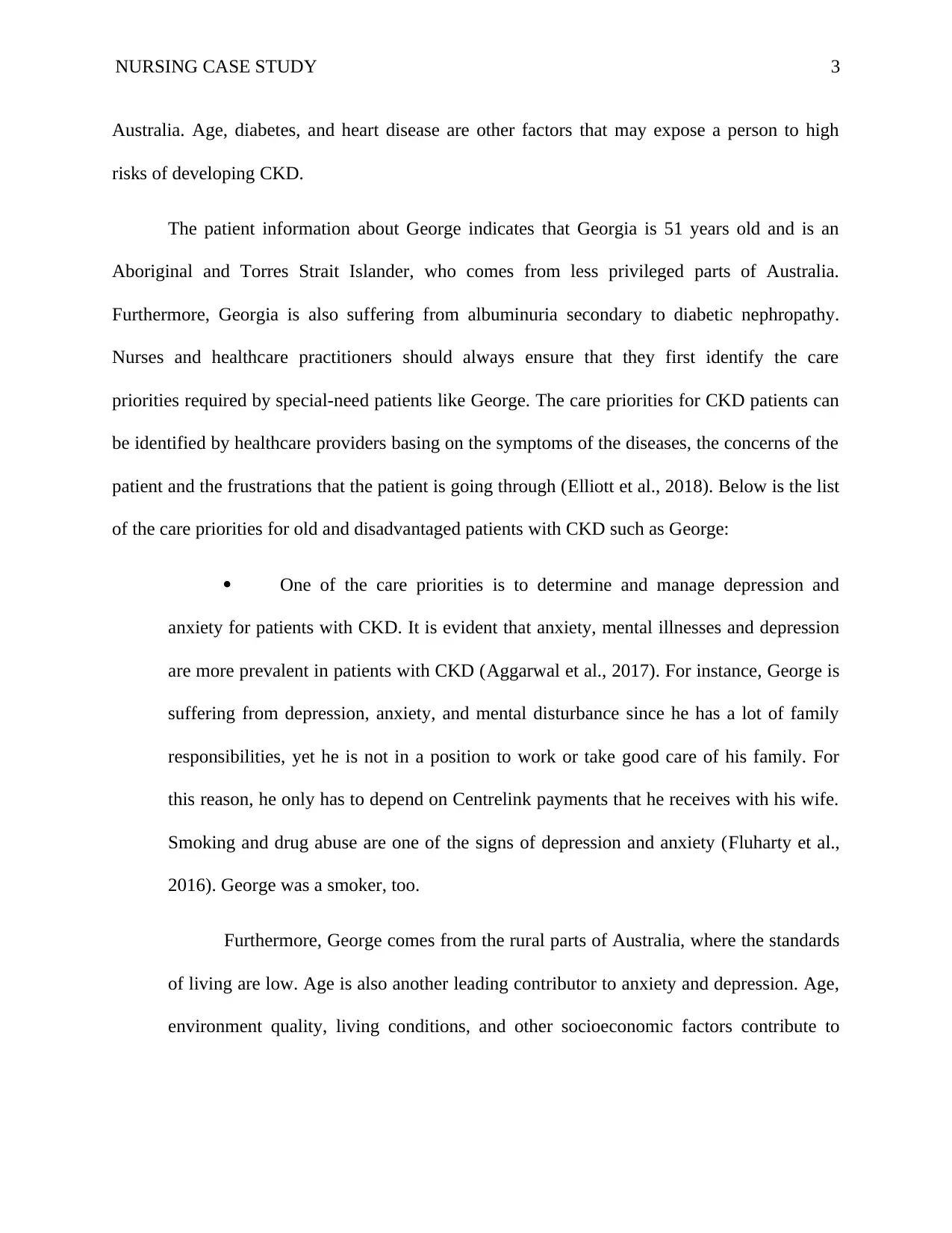
NURSING CASE STUDY 3
Australia. Age, diabetes, and heart disease are other factors that may expose a person to high
risks of developing CKD.
The patient information about George indicates that Georgia is 51 years old and is an
Aboriginal and Torres Strait Islander, who comes from less privileged parts of Australia.
Furthermore, Georgia is also suffering from albuminuria secondary to diabetic nephropathy.
Nurses and healthcare practitioners should always ensure that they first identify the care
priorities required by special-need patients like George. The care priorities for CKD patients can
be identified by healthcare providers basing on the symptoms of the diseases, the concerns of the
patient and the frustrations that the patient is going through (Elliott et al., 2018). Below is the list
of the care priorities for old and disadvantaged patients with CKD such as George:
One of the care priorities is to determine and manage depression and
anxiety for patients with CKD. It is evident that anxiety, mental illnesses and depression
are more prevalent in patients with CKD (Aggarwal et al., 2017). For instance, George is
suffering from depression, anxiety, and mental disturbance since he has a lot of family
responsibilities, yet he is not in a position to work or take good care of his family. For
this reason, he only has to depend on Centrelink payments that he receives with his wife.
Smoking and drug abuse are one of the signs of depression and anxiety (Fluharty et al.,
2016). George was a smoker, too.
Furthermore, George comes from the rural parts of Australia, where the standards
of living are low. Age is also another leading contributor to anxiety and depression. Age,
environment quality, living conditions, and other socioeconomic factors contribute to
Australia. Age, diabetes, and heart disease are other factors that may expose a person to high
risks of developing CKD.
The patient information about George indicates that Georgia is 51 years old and is an
Aboriginal and Torres Strait Islander, who comes from less privileged parts of Australia.
Furthermore, Georgia is also suffering from albuminuria secondary to diabetic nephropathy.
Nurses and healthcare practitioners should always ensure that they first identify the care
priorities required by special-need patients like George. The care priorities for CKD patients can
be identified by healthcare providers basing on the symptoms of the diseases, the concerns of the
patient and the frustrations that the patient is going through (Elliott et al., 2018). Below is the list
of the care priorities for old and disadvantaged patients with CKD such as George:
One of the care priorities is to determine and manage depression and
anxiety for patients with CKD. It is evident that anxiety, mental illnesses and depression
are more prevalent in patients with CKD (Aggarwal et al., 2017). For instance, George is
suffering from depression, anxiety, and mental disturbance since he has a lot of family
responsibilities, yet he is not in a position to work or take good care of his family. For
this reason, he only has to depend on Centrelink payments that he receives with his wife.
Smoking and drug abuse are one of the signs of depression and anxiety (Fluharty et al.,
2016). George was a smoker, too.
Furthermore, George comes from the rural parts of Australia, where the standards
of living are low. Age is also another leading contributor to anxiety and depression. Age,
environment quality, living conditions, and other socioeconomic factors contribute to
⊘ This is a preview!⊘
Do you want full access?
Subscribe today to unlock all pages.

Trusted by 1+ million students worldwide

NURSING CASE STUDY 4
depression and other mental illnesses in society. This ultimately worsens the condition of
patients such as George who is suffering from CKD.
Secondly, its fundamental to apply lifestyle changes in the management of
diabetes for patients with CKD (Hahr, 2015). This involves the control of blood sugar
levels in patients with CKD, especially before, during, and after a kidney transplant. In
the case study, George is also suffering from albuminuria which is secondary to diabetic
nephropathy. This condition can worsen CKD since it leads to an imbalance in the level
of glucose in the blood. Diabetic patients should, therefore, be given a priority when it
comes to the treatment and management of CKD.
Importantly, medical practitioners should always determine and identify
the genetic causes of CKD (Vivante, 2016). Since CKD can be passed from one family
member to another, it is essential for health care providers always to assess the genetic
factors that contribute to CKD among family members. In the case study, it is clear that
George genetically inherited the disease since the members of his extended family had
kidney failures, and they had to undergo through the process of dialysis. Thus, it is
important to conduct a genetic analysis and manage the genetic causes of the condition.
Monitoring of kidney function is another healthcare priority that patients
need (Alawadi et al., 2019). For people with inherited CKD and other kidney
complications, it is important for nurses to always monitor the kidney functions by
routinely assessing and checking the functionality of the kidney. This can be achieved by
conducting regular kidney tests, especially in elderly patients like George, who are at a
high risk of developing CKD.
depression and other mental illnesses in society. This ultimately worsens the condition of
patients such as George who is suffering from CKD.
Secondly, its fundamental to apply lifestyle changes in the management of
diabetes for patients with CKD (Hahr, 2015). This involves the control of blood sugar
levels in patients with CKD, especially before, during, and after a kidney transplant. In
the case study, George is also suffering from albuminuria which is secondary to diabetic
nephropathy. This condition can worsen CKD since it leads to an imbalance in the level
of glucose in the blood. Diabetic patients should, therefore, be given a priority when it
comes to the treatment and management of CKD.
Importantly, medical practitioners should always determine and identify
the genetic causes of CKD (Vivante, 2016). Since CKD can be passed from one family
member to another, it is essential for health care providers always to assess the genetic
factors that contribute to CKD among family members. In the case study, it is clear that
George genetically inherited the disease since the members of his extended family had
kidney failures, and they had to undergo through the process of dialysis. Thus, it is
important to conduct a genetic analysis and manage the genetic causes of the condition.
Monitoring of kidney function is another healthcare priority that patients
need (Alawadi et al., 2019). For people with inherited CKD and other kidney
complications, it is important for nurses to always monitor the kidney functions by
routinely assessing and checking the functionality of the kidney. This can be achieved by
conducting regular kidney tests, especially in elderly patients like George, who are at a
high risk of developing CKD.
Paraphrase This Document
Need a fresh take? Get an instant paraphrase of this document with our AI Paraphraser
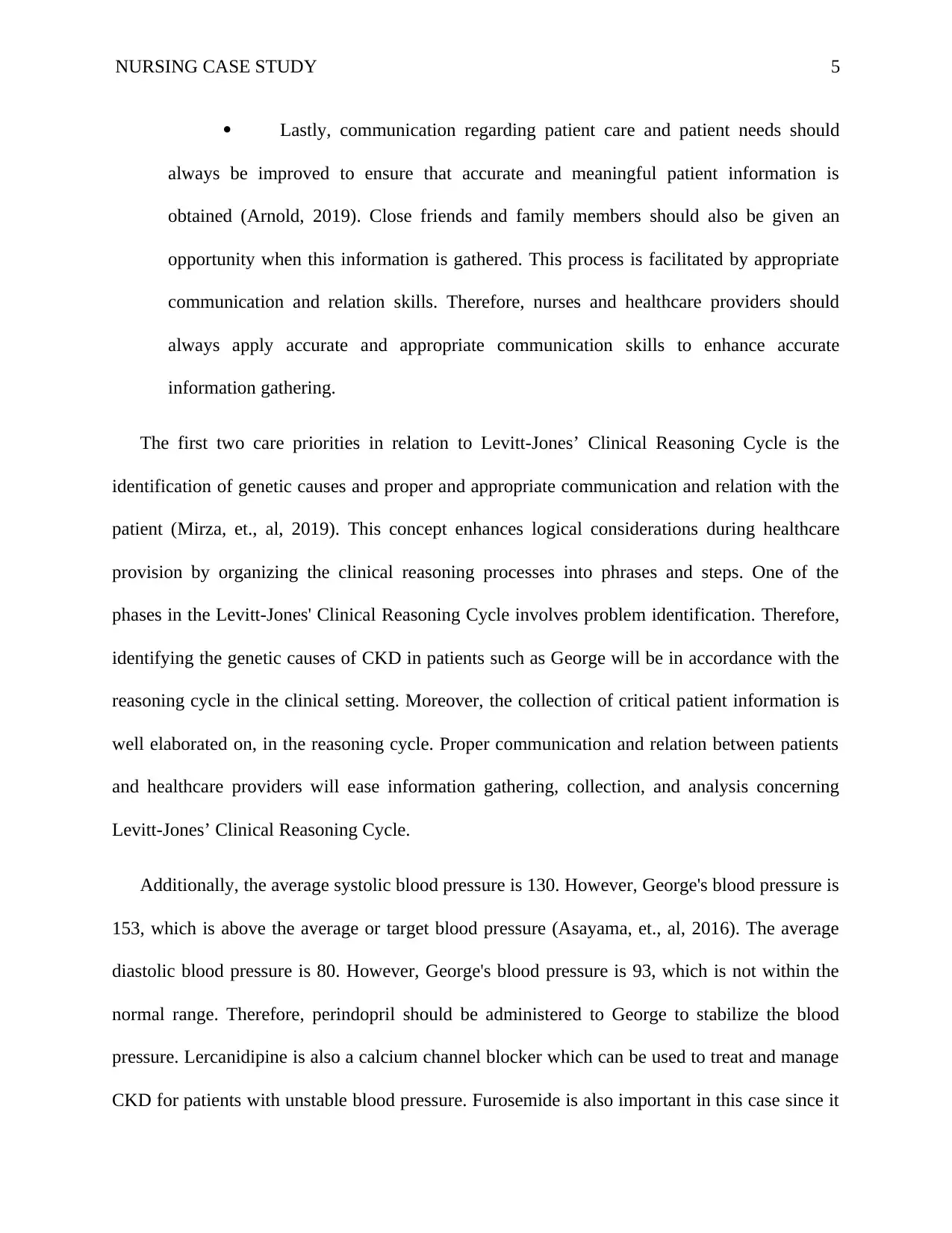
NURSING CASE STUDY 5
Lastly, communication regarding patient care and patient needs should
always be improved to ensure that accurate and meaningful patient information is
obtained (Arnold, 2019). Close friends and family members should also be given an
opportunity when this information is gathered. This process is facilitated by appropriate
communication and relation skills. Therefore, nurses and healthcare providers should
always apply accurate and appropriate communication skills to enhance accurate
information gathering.
The first two care priorities in relation to Levitt-Jones’ Clinical Reasoning Cycle is the
identification of genetic causes and proper and appropriate communication and relation with the
patient (Mirza, et., al, 2019). This concept enhances logical considerations during healthcare
provision by organizing the clinical reasoning processes into phrases and steps. One of the
phases in the Levitt-Jones' Clinical Reasoning Cycle involves problem identification. Therefore,
identifying the genetic causes of CKD in patients such as George will be in accordance with the
reasoning cycle in the clinical setting. Moreover, the collection of critical patient information is
well elaborated on, in the reasoning cycle. Proper communication and relation between patients
and healthcare providers will ease information gathering, collection, and analysis concerning
Levitt-Jones’ Clinical Reasoning Cycle.
Additionally, the average systolic blood pressure is 130. However, George's blood pressure is
153, which is above the average or target blood pressure (Asayama, et., al, 2016). The average
diastolic blood pressure is 80. However, George's blood pressure is 93, which is not within the
normal range. Therefore, perindopril should be administered to George to stabilize the blood
pressure. Lercanidipine is also a calcium channel blocker which can be used to treat and manage
CKD for patients with unstable blood pressure. Furosemide is also important in this case since it
Lastly, communication regarding patient care and patient needs should
always be improved to ensure that accurate and meaningful patient information is
obtained (Arnold, 2019). Close friends and family members should also be given an
opportunity when this information is gathered. This process is facilitated by appropriate
communication and relation skills. Therefore, nurses and healthcare providers should
always apply accurate and appropriate communication skills to enhance accurate
information gathering.
The first two care priorities in relation to Levitt-Jones’ Clinical Reasoning Cycle is the
identification of genetic causes and proper and appropriate communication and relation with the
patient (Mirza, et., al, 2019). This concept enhances logical considerations during healthcare
provision by organizing the clinical reasoning processes into phrases and steps. One of the
phases in the Levitt-Jones' Clinical Reasoning Cycle involves problem identification. Therefore,
identifying the genetic causes of CKD in patients such as George will be in accordance with the
reasoning cycle in the clinical setting. Moreover, the collection of critical patient information is
well elaborated on, in the reasoning cycle. Proper communication and relation between patients
and healthcare providers will ease information gathering, collection, and analysis concerning
Levitt-Jones’ Clinical Reasoning Cycle.
Additionally, the average systolic blood pressure is 130. However, George's blood pressure is
153, which is above the average or target blood pressure (Asayama, et., al, 2016). The average
diastolic blood pressure is 80. However, George's blood pressure is 93, which is not within the
normal range. Therefore, perindopril should be administered to George to stabilize the blood
pressure. Lercanidipine is also a calcium channel blocker which can be used to treat and manage
CKD for patients with unstable blood pressure. Furosemide is also important in this case since it
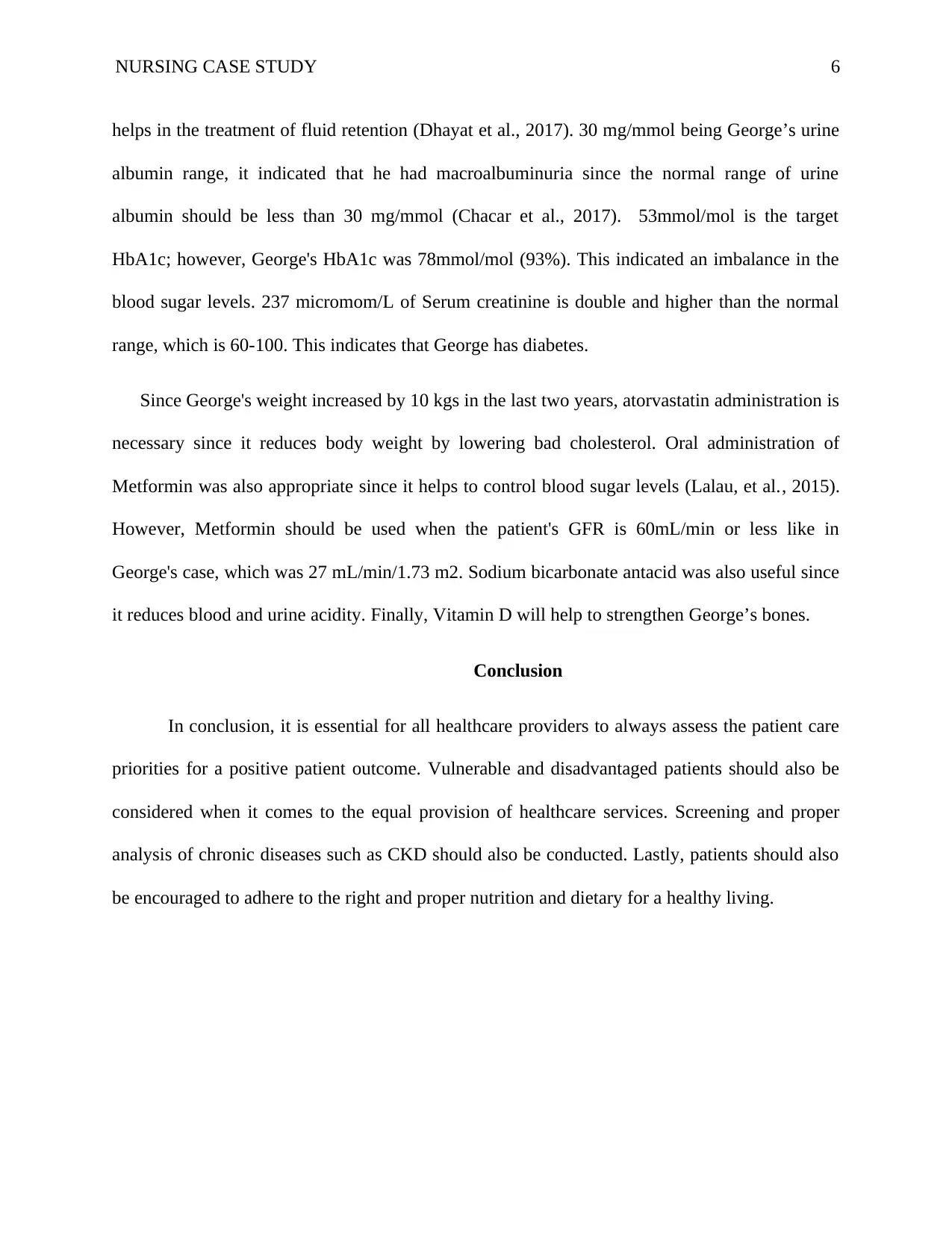
NURSING CASE STUDY 6
helps in the treatment of fluid retention (Dhayat et al., 2017). 30 mg/mmol being George’s urine
albumin range, it indicated that he had macroalbuminuria since the normal range of urine
albumin should be less than 30 mg/mmol (Chacar et al., 2017). 53mmol/mol is the target
HbA1c; however, George's HbA1c was 78mmol/mol (93%). This indicated an imbalance in the
blood sugar levels. 237 micromom/L of Serum creatinine is double and higher than the normal
range, which is 60-100. This indicates that George has diabetes.
Since George's weight increased by 10 kgs in the last two years, atorvastatin administration is
necessary since it reduces body weight by lowering bad cholesterol. Oral administration of
Metformin was also appropriate since it helps to control blood sugar levels (Lalau, et al., 2015).
However, Metformin should be used when the patient's GFR is 60mL/min or less like in
George's case, which was 27 mL/min/1.73 m2. Sodium bicarbonate antacid was also useful since
it reduces blood and urine acidity. Finally, Vitamin D will help to strengthen George’s bones.
Conclusion
In conclusion, it is essential for all healthcare providers to always assess the patient care
priorities for a positive patient outcome. Vulnerable and disadvantaged patients should also be
considered when it comes to the equal provision of healthcare services. Screening and proper
analysis of chronic diseases such as CKD should also be conducted. Lastly, patients should also
be encouraged to adhere to the right and proper nutrition and dietary for a healthy living.
helps in the treatment of fluid retention (Dhayat et al., 2017). 30 mg/mmol being George’s urine
albumin range, it indicated that he had macroalbuminuria since the normal range of urine
albumin should be less than 30 mg/mmol (Chacar et al., 2017). 53mmol/mol is the target
HbA1c; however, George's HbA1c was 78mmol/mol (93%). This indicated an imbalance in the
blood sugar levels. 237 micromom/L of Serum creatinine is double and higher than the normal
range, which is 60-100. This indicates that George has diabetes.
Since George's weight increased by 10 kgs in the last two years, atorvastatin administration is
necessary since it reduces body weight by lowering bad cholesterol. Oral administration of
Metformin was also appropriate since it helps to control blood sugar levels (Lalau, et al., 2015).
However, Metformin should be used when the patient's GFR is 60mL/min or less like in
George's case, which was 27 mL/min/1.73 m2. Sodium bicarbonate antacid was also useful since
it reduces blood and urine acidity. Finally, Vitamin D will help to strengthen George’s bones.
Conclusion
In conclusion, it is essential for all healthcare providers to always assess the patient care
priorities for a positive patient outcome. Vulnerable and disadvantaged patients should also be
considered when it comes to the equal provision of healthcare services. Screening and proper
analysis of chronic diseases such as CKD should also be conducted. Lastly, patients should also
be encouraged to adhere to the right and proper nutrition and dietary for a healthy living.
⊘ This is a preview!⊘
Do you want full access?
Subscribe today to unlock all pages.

Trusted by 1+ million students worldwide
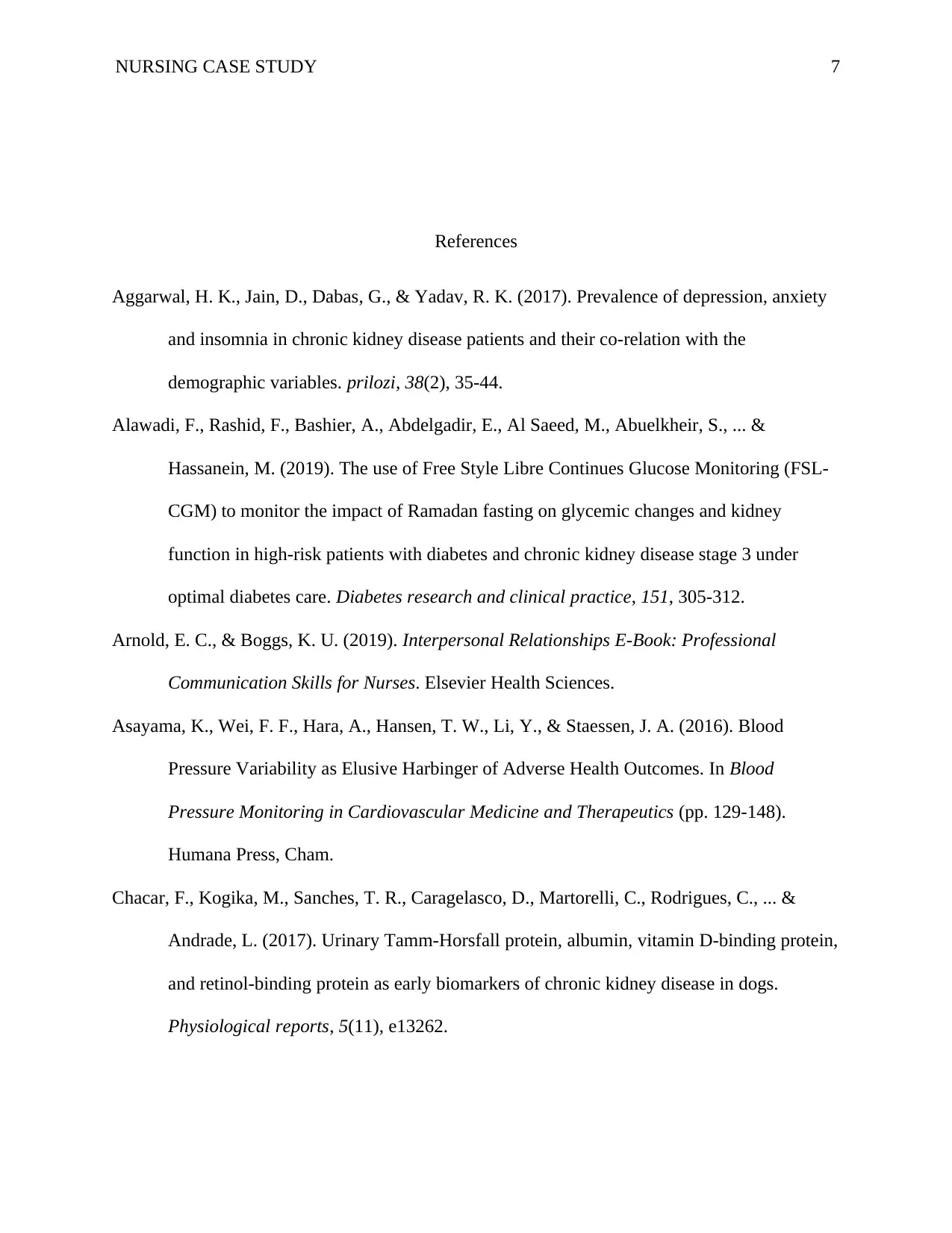
NURSING CASE STUDY 7
References
Aggarwal, H. K., Jain, D., Dabas, G., & Yadav, R. K. (2017). Prevalence of depression, anxiety
and insomnia in chronic kidney disease patients and their co-relation with the
demographic variables. prilozi, 38(2), 35-44.
Alawadi, F., Rashid, F., Bashier, A., Abdelgadir, E., Al Saeed, M., Abuelkheir, S., ... &
Hassanein, M. (2019). The use of Free Style Libre Continues Glucose Monitoring (FSL-
CGM) to monitor the impact of Ramadan fasting on glycemic changes and kidney
function in high-risk patients with diabetes and chronic kidney disease stage 3 under
optimal diabetes care. Diabetes research and clinical practice, 151, 305-312.
Arnold, E. C., & Boggs, K. U. (2019). Interpersonal Relationships E-Book: Professional
Communication Skills for Nurses. Elsevier Health Sciences.
Asayama, K., Wei, F. F., Hara, A., Hansen, T. W., Li, Y., & Staessen, J. A. (2016). Blood
Pressure Variability as Elusive Harbinger of Adverse Health Outcomes. In Blood
Pressure Monitoring in Cardiovascular Medicine and Therapeutics (pp. 129-148).
Humana Press, Cham.
Chacar, F., Kogika, M., Sanches, T. R., Caragelasco, D., Martorelli, C., Rodrigues, C., ... &
Andrade, L. (2017). Urinary Tamm‐Horsfall protein, albumin, vitamin D‐binding protein,
and retinol‐binding protein as early biomarkers of chronic kidney disease in dogs.
Physiological reports, 5(11), e13262.
References
Aggarwal, H. K., Jain, D., Dabas, G., & Yadav, R. K. (2017). Prevalence of depression, anxiety
and insomnia in chronic kidney disease patients and their co-relation with the
demographic variables. prilozi, 38(2), 35-44.
Alawadi, F., Rashid, F., Bashier, A., Abdelgadir, E., Al Saeed, M., Abuelkheir, S., ... &
Hassanein, M. (2019). The use of Free Style Libre Continues Glucose Monitoring (FSL-
CGM) to monitor the impact of Ramadan fasting on glycemic changes and kidney
function in high-risk patients with diabetes and chronic kidney disease stage 3 under
optimal diabetes care. Diabetes research and clinical practice, 151, 305-312.
Arnold, E. C., & Boggs, K. U. (2019). Interpersonal Relationships E-Book: Professional
Communication Skills for Nurses. Elsevier Health Sciences.
Asayama, K., Wei, F. F., Hara, A., Hansen, T. W., Li, Y., & Staessen, J. A. (2016). Blood
Pressure Variability as Elusive Harbinger of Adverse Health Outcomes. In Blood
Pressure Monitoring in Cardiovascular Medicine and Therapeutics (pp. 129-148).
Humana Press, Cham.
Chacar, F., Kogika, M., Sanches, T. R., Caragelasco, D., Martorelli, C., Rodrigues, C., ... &
Andrade, L. (2017). Urinary Tamm‐Horsfall protein, albumin, vitamin D‐binding protein,
and retinol‐binding protein as early biomarkers of chronic kidney disease in dogs.
Physiological reports, 5(11), e13262.
Paraphrase This Document
Need a fresh take? Get an instant paraphrase of this document with our AI Paraphraser

NURSING CASE STUDY 8
Dhayat, N. A., Gradwell, M. W., Pathare, G., Anderegg, M., Schneider, L., Luethi, D., ... &
Fuster, D. G. (2017). Furosemide/fludrocortisone test and clinical parameters to diagnose
incomplete distal renal tubular acidosis in kidney stone formers. Clinical Journal of the
American Society of Nephrology, 12(9), 1507-1517.
Elliott, M. J., Sale, J. E., Goodarzi, Z., Wilhelm, L., Laupacis, A., Hemmelgarn, B. R., & Straus,
S. E. (2018). Long‐term views on chronic kidney disease research priorities among
stakeholders engaged in a priority‐setting partnership: A qualitative study. Health
Expectations, 21(6), 1142-1149.
Fluharty, M., Taylor, A. E., Grabski, M., & Munafò, M. R. (2016). The association of cigarette
smoking with depression and anxiety: a systematic review. Nicotine & Tobacco
Research, 19(1), 3-13.
Hahr, A. J., & Molitch, M. E. (2015). Management of diabetes mellitus in patients with chronic
kidney disease. Clinical diabetes and endocrinology, 1(1), 2.
Lalau, J. D., Arnouts, P., Sharif, A., & De Broe, M. E. (2015). Metformin and other antidiabetic
agents in renal failure patients. Kidney international, 87(2), 308-322.
Mirza, N., Manankil-Rankin, L., Prentice, D., Hagerman, L. A., & Draenos, C. (2019). Practice
Readiness Of New Nursing Graduates: A Concept Analysis. Nurse education in practice.
Vivante, A., & Hildebrandt, F. (2016). Exploring the genetic basis of early-onset chronic kidney
disease. Nature Reviews Nephrology, 12(3), 133.
Webster, A. C., Nagler, E. V., Morton, R. L., & Masson, P. (2017). Chronic kidney disease. The
lancet, 389(10075), 1238-1252.
Dhayat, N. A., Gradwell, M. W., Pathare, G., Anderegg, M., Schneider, L., Luethi, D., ... &
Fuster, D. G. (2017). Furosemide/fludrocortisone test and clinical parameters to diagnose
incomplete distal renal tubular acidosis in kidney stone formers. Clinical Journal of the
American Society of Nephrology, 12(9), 1507-1517.
Elliott, M. J., Sale, J. E., Goodarzi, Z., Wilhelm, L., Laupacis, A., Hemmelgarn, B. R., & Straus,
S. E. (2018). Long‐term views on chronic kidney disease research priorities among
stakeholders engaged in a priority‐setting partnership: A qualitative study. Health
Expectations, 21(6), 1142-1149.
Fluharty, M., Taylor, A. E., Grabski, M., & Munafò, M. R. (2016). The association of cigarette
smoking with depression and anxiety: a systematic review. Nicotine & Tobacco
Research, 19(1), 3-13.
Hahr, A. J., & Molitch, M. E. (2015). Management of diabetes mellitus in patients with chronic
kidney disease. Clinical diabetes and endocrinology, 1(1), 2.
Lalau, J. D., Arnouts, P., Sharif, A., & De Broe, M. E. (2015). Metformin and other antidiabetic
agents in renal failure patients. Kidney international, 87(2), 308-322.
Mirza, N., Manankil-Rankin, L., Prentice, D., Hagerman, L. A., & Draenos, C. (2019). Practice
Readiness Of New Nursing Graduates: A Concept Analysis. Nurse education in practice.
Vivante, A., & Hildebrandt, F. (2016). Exploring the genetic basis of early-onset chronic kidney
disease. Nature Reviews Nephrology, 12(3), 133.
Webster, A. C., Nagler, E. V., Morton, R. L., & Masson, P. (2017). Chronic kidney disease. The
lancet, 389(10075), 1238-1252.
1 out of 8
Related Documents
Your All-in-One AI-Powered Toolkit for Academic Success.
+13062052269
info@desklib.com
Available 24*7 on WhatsApp / Email
![[object Object]](/_next/static/media/star-bottom.7253800d.svg)
Unlock your academic potential
Copyright © 2020–2025 A2Z Services. All Rights Reserved. Developed and managed by ZUCOL.





